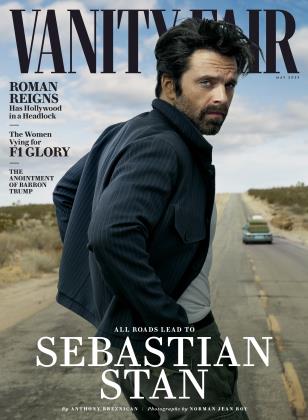Sign In to Your Account
Subscribers have complete access to the archive.
Sign In Not a Subscriber?Join NowPoeticHARMONY
With "A Poem for Deep Thinkers" at the Guggenheim Museum, RASHID JOHNSON revisits his archive
Vanities /Art
ARTIST RASHID JOHNSON has recently let the light in, renovating the ceilings ofhis Brooklyn studio to flood the space via skylight. "A Poem for Deep Thinkers," the largest exhibition of Johnson's work to date, does something similar, as the Guggenheim spotlights his multidisciplinary practice over the course ofhis three-decade career.
Filling the museum's Frank Lloyd Wright-designed rotunda, the career survey features nearly 90 works exploring themes of self-examination, liminal space, and legacy in what Johnson calls an "investigation of my own experiences and ideas and understanding of the world."
The exhibit, which includes blacksoap paintings, large-scale indoor and outdoor sculpture, film, and video, takes its name from a poem by the late writer and political activist Amiri Baraka, whose presence looms large in Johnson's oeuvre. "That poem is an interesting challenge," the artist says of the text, which Baraka performed at the New College of California in 1977, the year Johnson was born, "it feels prescient in some respect. He is really, in a sense, trying to hold accountable an educated class of folks and calling into question where their loyalties lie and where their ambitions lie, and questioning their sense of action and their sense of responsibility."
In the creation of the show, Baraka's words once again compelled Johnson. "Consistently I'm asking myself, what are the intentions of these objects? What are the goals of this project? And do my actions live up to my ambitions?" he says. "One of the kinds of really significant transgressions in an artist project is the willingness to selfchallenge and the willingness to recognize your limitations, but at the same time question what is at the center of your project. I don't have— and I wish I did—but I don't have solutions in my project."
Throughout Johnson's evolution, his work has remained highly referentialconjuring academics, activists, and authors like Harold Cruse, Angela Davis, Octavia Butler, Toni Morrison, and historical figures including Frederick Douglass and W.E.B. Du Bois. "I really don't think of them as archived, resolved voices," he says. "I see them as current contributors in my thinking, and their critical positioning and the critical positions that they activated as being spaces for me to navigate and update and explore." Recently, self-reference has become more approachable. "Previously, I would've been intimidated to use 'the soul' or 'God' or 'beauty,' " he says. "There's a different confidence that comes from allowing your own experience in a different way, soulfully, to impact what it is you're making."
As Johnson prepares for the exhibition, one wonders, does he write poetry? "I did for many years, but not so much anymore," he recalls, sitting back on a sectional under the skylight. "I consider now the artworks that I make, the visual artworks, as poems." Such is keeping company with deep thinkers.
ARIMETA DIOP
 View Full Issue
View Full Issue












Subscribers have complete access to the archive.
Sign In Not a Subscriber?Join Now